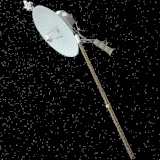 |
|
|
Voyager
view of Callisto's Valhalla impact basin.
|
|
| CALLISTO - MOON OF JUPITER | |
| Callisto is the eighth of Jupiter's known moons, and the second largest. Callisto was discovered in 1610 by Galileo Galilei, and hence it is now known as one of the Galilean moons. Callisto was a nymph who was changed into a bear by Hera, and placed in the sky by Zeus. (Zeus is the Greek mythological equivalent of the Roman god Jupiter). The bear in the story is the well-known constellation Ursa Major, also known as The Plough or Big Dipper. | |
| Locked into Jupiter | |
| Callisto is the outermost Galilean moon, and, like the other Galilean moons, has a rotation that is tidally locked by Jupiter's gravity. The rotation of Callisto is synchronous - it always keeps the same hemisphere facing Jupiter. However, being further from Jupiter than the other Galilean moons, all available heat sources are of less importance, and this has effected Callisto's interior and geological history. | |
 Callisto's orbit. |
|
| A Large Moon | |
| With a diameter of over 4,800 kilometres Callisto is the third largest moon in the Solar System (Ganymede is the largest and Titan the second largest). In fact, Callisto is only just smaller than the planet Mercury. Callisto has the lowest density of the Galilean satellites. Although the size is similar to Mercury's, the density is a third. Callisto may have the volume of a planet, but lacks the substance to be a serious contender. | |
 Moon and Callisto comparison. |
|
| Interior | |
| The low density of Callisto suggests an interior composed of rock and ice, with a metal core at the centre. However, recent observations suggest that Callisto may have an ocean, similar to Europa's. | |
 Callisto's interior. |
|
| Magnetic field | |
| A weak and variable magnetic field has been detected around Callisto. The origin is uncertain - one possibility is that the field is generated by electrical currents flowing through Callisto's surface. The cause of the electrical currents could be Jupiter's magnetic field, which will vary at Callisto as Jupiter rotates. The detection of a magnetic field has implications for Callisto's interior structure. | |
| Atmosphere | |
| No atmosphere has been discovered on Callisto. | |
| An eventful geological history | |
| Callisto is one of the most heavily cratered satellites in the Solar System. Lacking any significant volcanic or tectonic disruption, Callisto appears to have a simple geological past. The numerous craters record an eventful history nonetheless, and tell us a great deal about the properties and composition of the outermost Galilean moon. | |
 Dense cratering on Callisto's surface. |
|
| Exploration | |
| Callisto has been visited by Pioneer, Voyager, and Galileo spacecraft. The Galileo spacecraft has returned the most detailed images of Callisto's surface, providing the greatest amount of information concerning Callisto since the moon's discovery in 1610. | |
 The Voyager spacecraft. |
|
|
|
|